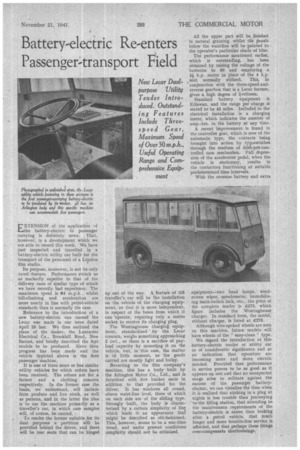Battery-electric Re-enters Passenger-transport Field
Page 25

If you've noticed an error in this article please click here to report it so we can fix it.
La XTENSION of the application (-4
the battery-electric to passenger carrying is definitely news. That, however; is a development which we are able to record this week. We have .just inspected and travelled in a battery-electric utility car built for the transport of the personnel of a LOndon • film studio.
Its purpose, moreover, is not its only• novel feature. Performance struck us as markedly superior to that of the delivery vans of similar type of which we have recently had experience. The maximum speed is t 4 m.p.h., whilst hill-climbing and acceleration are more nearly in line with petrol-vehicle standards than is normally the case.
Reference to the introduction of a new battery-electric van named the Lecar was made in our issue dated April 25 last. We then outlined the plans of the maker, the Lancaster Electrical Co., Brookhill Road, New Barnet, and briefly described the first models to be produced. Since then progress has been made and the vehicle depicted above is the first passenger machine.
It is one of three more or less similar utility vehicles for which orders have been received. The others are for a farmer and a clothing concern respectively. In the former case the loads, we understand, , will include farm produce and live stock, as well as persons, and in the latter the idea is ' to use the, machine primarily as a traveller's car, in which case samples will, of coarse, be carried.
To render the former suitable for its dual purposes a partition will be provided behind the driver, and there will be rear seats that can be hinged U p out of the way. A feature of tht traveller's car will be the installation on the vehicle of the charging equipment, so that it is more independent, in respect of the bases from which it can 'operate, requiring only a mains socket to receive its charging plug.
The Westinghouse charging equipment, standardized by the Lecar concern, weighs something approaching 2 cwt., so there is a sacrifice of payload capacity by mounting it on the vehicle, but, in this case, the matter is Of little moment, as the goods carried are mostly light and bulky.
Reverting to the film company's machine, this has a body built by the Arlington Motor Co., Ltd., and is furnished with five bucket seats in addition to that provided for the driver. It has windows all round, above waist-line level, three of which on each side are of the sliding type. Strongly built, the body is characterized by a certain simplicity of line which lends it an appearance that might be described as old-fashioned. This, however, seems to be a war-time trend, and under present conditions simplicity should not be criticized. All the upper part will be finished in natural graining, whilst the panels below the waistline will be painted to the operator's particular shade of blue.
The performance mentioned earlier, which is outstanding, has been obtained by raising the voltage of the batteries to 60 and employing a 4i h.p. motor in place of the 4 h.p. unit normally utilized. This, in conjunction with the three-speed-andreverse gearbox that is a Lecar feature, gives a high degree of liveliness.
Standard battery equipment is Ediswan, and the range per charge is stated to be 43 miles. Included in the electrical installation isa charging meter, which indicates the number of amp.-hrs. in, the battery at any time.
A recent improvement is found in the controller gear, which is now of the automatic type, the contacts being brought into action by trip-switches through the medium of da'sh-pot-controlled cam mechanism, Full depression of the accelerator pedal, when the vehicle is stationary, results in the contactors functioning at suitable predetermined time intervals.
With the oversize battery and extra equipment—two head lamps, windscreen wiper, speedometer, immobilizing main-switch lock, etc., the price of the complete tender is 4373, which figure includes the Westinghouse charger. In standard form, the model, without charger, is listed at £275.
Although wire-spoked wheels are seen on this machine, future modelswill have wheels of the " easy-clean " type.
We regard the introduction of this battery-electric tender or utility car as of considerable significance and as an indication that operators are becoming more and more electric minded. Provided that performance in service proves to be as good as it appears on test and that no unexpected snags arise to militate against the success of the passenger batteryelectric, we can visualize the time when it is realized that sticking in a plug at nights is less trouble than journeying 'to--the filling station, that attending to the maintenance requirements of the battery-electric is easier, than looking after a petrol vehicle, that much longer and more trouble-free service is afforded, and that perhaps these things over-compensate shortcomings.




















































